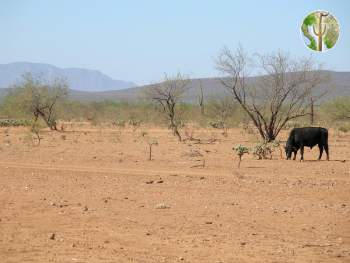Ranching and Overgrazing in Sonora
Cattle grazing is the default use of most land in Sonora. It is a large part of life for rural people of Sonora and contributes to a number of people's incomes. It is also the source of the state's official food: the carne asada taco. While less obvious and initially disturbing to some eyes than other destructive activities, grazing has an unparalleled and widespread negative effect on ecosystems in Sonora, especially when you consider that much of Sonora would practically be untouched wilderness otherwise.
Grazing strips vegetation, groundcover, and topsoil, lessening the productivity of a given ecosystem. This means lost diversity, missing species, and a decline in biomass. Over the long-term the impacts compound and are even greater. The effects are so numerous that I can't give a complete synopsis, but below are some of its detrimental effects.
 Overgrazing strips land of the bases of a healthy functioning ecosystem - diverse and full vegetation, healthy soil, and moisture - causing a ripple effect through the entire ecosystem, lessening productivity in everything from microscopic organisms to the top of the food chain with animals such as Eagles and Jaguars. Interestingly problems are also caused in reverse with ranchers killing off large carnivores and competitors creating a negative effect on ecosystems from the top down.
Overgrazing strips land of the bases of a healthy functioning ecosystem - diverse and full vegetation, healthy soil, and moisture - causing a ripple effect through the entire ecosystem, lessening productivity in everything from microscopic organisms to the top of the food chain with animals such as Eagles and Jaguars. Interestingly problems are also caused in reverse with ranchers killing off large carnivores and competitors creating a negative effect on ecosystems from the top down.
Most people have never seen the full impact of cattle grazing in this part of the world, having never seen a pre-grazed state. Full recovery can't be seen in a lifetime in many areas and could take thousands of years for topsoil to rebuild and waterways and aquifers to replenish.
Non-native species are spread by cattle both through cattle altering native landscapes, creating better habitat for many non-natives, as well as by physically disbursing their seed. Ranchers blade and clear native vegetation in many parts of Sonora, often over large areas, and plant invasive species, often Buffelgrass, which is impacting Sonoran Desert ecosystems heavily. Roads intrude on wild areas in Sonora primarily for livestock management are are the main vector for invasive plants throughout Sonora.
Cattle grazing is especially destructive to important riparian areas. Cattle love to hang out in cool most riparian areas full of lush, edible vegetation and water. Riparian ecosystems in the desert are very susceptible to many forms of destruction. All important streamside vegetation is completely trampled and chomped. Many species such as frogs have disappeared due to missing streamside vegetation, which also is important for stabilizing soils and preventing erosion. Many areas with heavy grazing lose cottonwood/willow gallery forest in the long run because every young tree is eaten and eventually when older trees die out nothing is left to replace them.
A huge, but little written about problem is that water infiltration over the entire landscape is severely diminished by cows stripping off vegetation and organic matter. This water ends up flooding downstream causing erosion instead of infiltrating into aquifers, springs, and creeks. This eventually causes the complete disappearance of many springs and creeks, a problem seen in late 1800's and 1900's in the southwest U.S. and often not understood. More historical loss of riparian ecosystems was caused by cattle grazing than anything else. Groundwater pumping is a huge problem and comes in at number two, although with most of the smaller creeks now gone it is becoming the biggest threat to remaining riparian ecosystems, with the ripple effects of lost infiltration still contributing.
Overgrazing causes fertile topsoil to wash and blow away, a large-scale impact that lasts hundreds or even thousands of years. Entire ecosystems of plants and animals disappear due to this effect, which goes little-noticed by most humans.
Ranchers to this day kill huge numbers of predators (and sometimes competing forage animals) including Jaguars, Mountain Lions, raptors, Coyotes, and many others.
